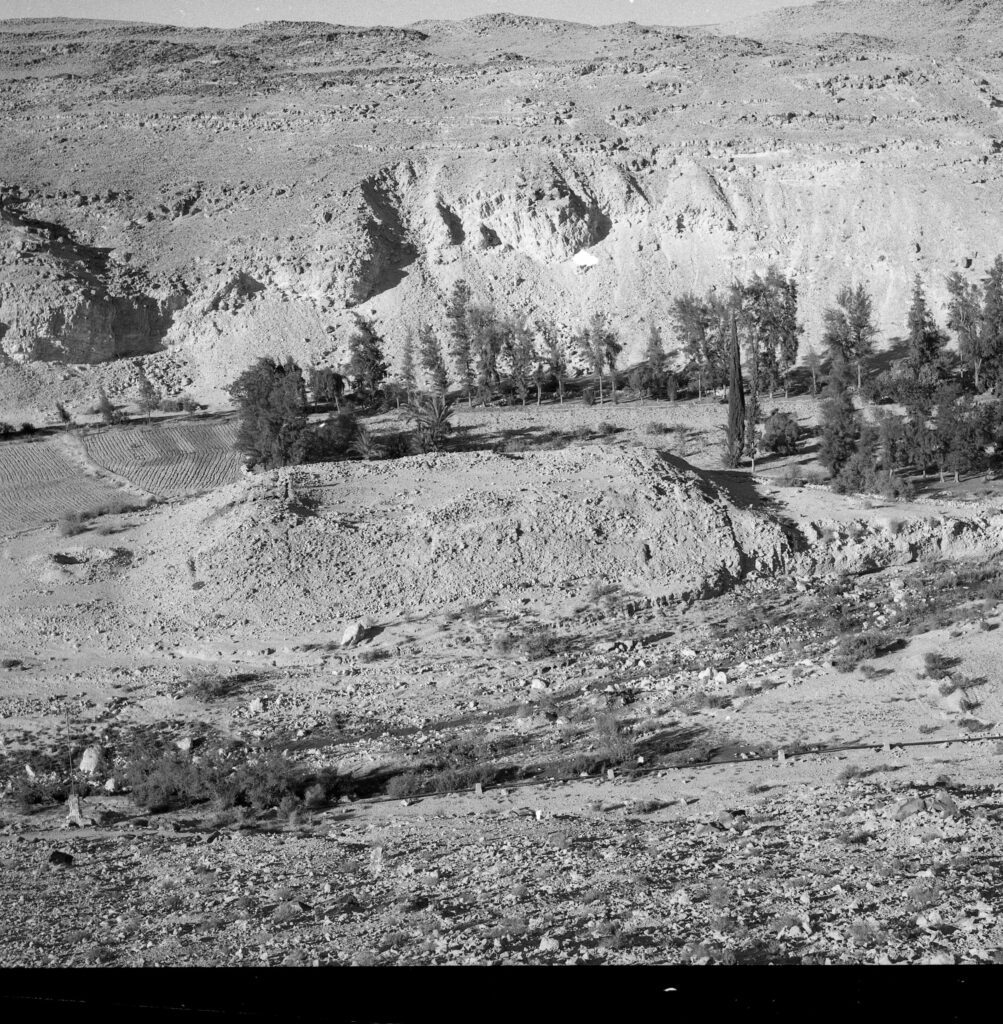A mound with the remains of a citadel from the Iron Age in the Ein al-Qudeirat valley in northeastern Sinai, near the Israeli border. The mound is identified with the biblical Kadesh Barnea. The citadel that was discovered at the beginning of this century and its plan has since been used as a classic example of an Israeli citadel.Tell el-Qudeirat is one of the dozens of permanent settlements that existed during the Second Iron Age in the Negev Mountains.

The first archaeologists who noticed the mound were T. Lawrence “Ish Arab” and S.L. Wally in 1914. They proposed that Tell el-Qudeirat is the biblical Kadesh-Barnea.
Additional work on a limited scale was carried out on the mound by Moshe Dotan in 1956 (probably right after Operation Kadesh) and the area was surveyed by his son Rothenberg in the late 1960s.
Nelson Gluck (published in 1959) and Yochanan Aharoni (1967) discovered that a large number of other Iron Age masades also exist in the area, and suggested that these masades were built by the kings of Israel to increase their influence on this area towards the southern end of their dominions. Dotan concluded that the citadel itself existed in the eighth to sixth centuries, with evidence of human settlement in the place before and after its existence.
After the Six Day War, Rudolf Cohen conducted work on a much larger scale in 1976-1982. Cohen concluded that the site actually contains the remains of three citadels. The first was built in the tenth century, in the shape of an oval. The second and third were rectangular. The second was built in the 8th century BC and was destroyed in the 7th century BC. According to his third claim, it was built in the second half of the 6th century BC and was destroyed in 586 BC. Despite the destruction of the last citadel, the site continued to be inhabited for about two hundred years.
Mordechai Hyman (1994) claimed that these settlements were established by the united Israelite monarchy between the years 1000 and 925 BC. Hyman stated that these sites were abandoned after the Kingdom of Israel split and Egypt invaded it around 925 BC. Of these sites, Hayman claims that only Tell al-Kudirat and two others were settled again in the eighth century, when Tell al-Kudirat served as an outpost of the Kingdom of Judah.
David Osishkin (1995), on the other hand, claimed that Cohen’s “second” and “third” citadel actually constitute one citadel. While Cohen interpreted it as an outpost of the Kingdom of Judah, Osishkin suggested, following Nadav Naaman, that it was not a project of the Judean government but was perhaps built by the Assyrians, and then fell into the hands of Egypt.
Israel Finkelstein expanded the lines of thinking found in Cohen and Osishkin, while changing some of their conclusions. What Cohen saw as an “oval fortress”, Finkelstein sees simply as the remains of a settlement between the tenth and eighth centuries, before the construction of a fortress. As for the rectangular remains, Finkelstein believes that these are part of one citadel that operated from the middle of the 8th century until the end of the 7th century.
Remains of various aqueducts were found on the mound, which enabled carbon-14 dating. They were dated in the range of 1673-1454 BC (the end of the Middle Bronze to the beginning of the Late Bronze). The ash layer that researchers associate with the Lower Citadel gave a carbon-14 date in the range of 1210-1050 BC (Iron Age 1).
Sources
Cohen, Rudolph. (1979). “The Iron Age Fortresses in the Central Negev”. Bulletin of the American Schools of Oriental Research, (236).
Cohen, Rudolph and Hannah Bernick-Greenberg (2007). Excavations at Kadesh Barnea (Tell el-Qudeirat). Israel Antiquities Authority.
Dothan, Moshe (1965). “The Fortress at Kadesh-Barnea”. Israel Exploration Journal, Vol. 15, no. 3, pp. 134–150.
Finkelstein, Israel (2010). “Kadesh Barnea: A Reevaluation of Its Archeology and History.” Tel Aviv (volume 37).
Haiman, Mordechai (1994) “The Iron Age II Sites of the Western Negev Highlands”. Israel Exploration Journal. Vol. 44, no. 1/2, pp. 36-61
Ussishkin, David (1995). “The Rectangular Fortress at Kadesh-Barnea”. Israel Exploration Journal, Vol. 45, no. 2/3..
Woolley, C. Leonard and Lawrence, T. E. (1914). The Wilderness of Zin. Palestine Exploration Fund.


